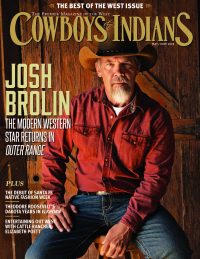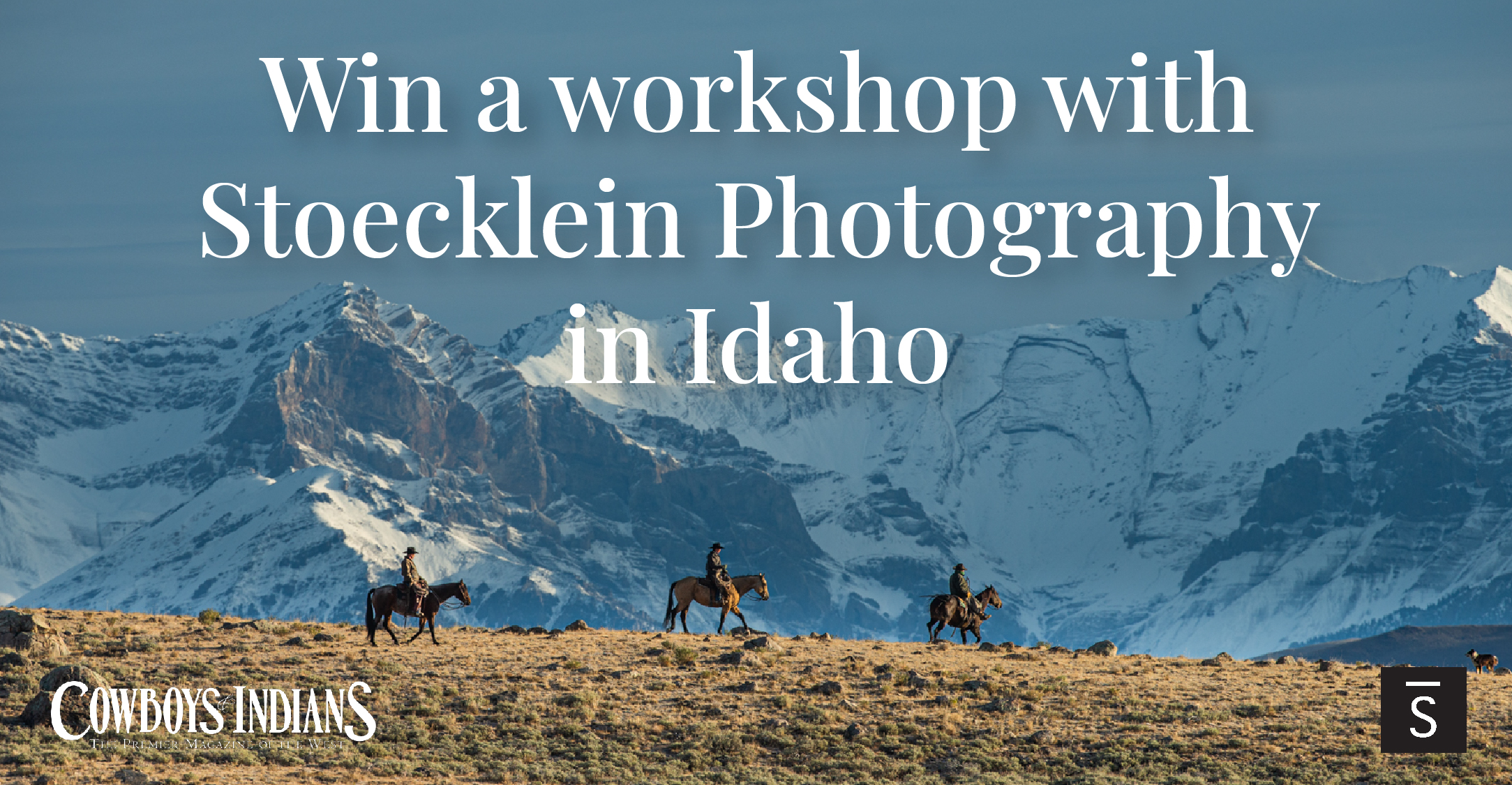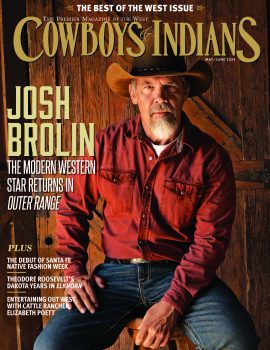We've rounded up our picks for people, places, and passions that keep the West alive.
The Sensory Education of a Powwow
Powwows might just be the most exhilarating way to go total immersion in Native American culture. Lucky for us, the tradition is alive and well around the country where you find concentrations of Native American tribes. And that means lots of possibilities in the West, including the Gathering of Nations in Albuquerque, New Mexico, the Red Earth Festival in Oklahoma City, the Denver March Powwow, and the United Tribes International Powwow in Bismarck, North Dakota, to name just a few.
One of our favorites is Crow Fair in Crow Agency, Montana. Parades, a four-day powwow, a rodeo, horse races, and the distinction of being the “Tepee Capital of the World” — it’s the largest Native American event in the state and one of the biggest powwows in the country.
We asked C&I contributor Erika Haight, a fine art photographer and adopted member of the Crow tribe, for an insider’s view of the cultural wonder that is Crow Fair:
The first thing you’re taken by is the vast number of people, cars, and horses that crisscross in front of you as you try to park. If you arrive early enough, you’ll hear the camp criers, singing their morning praise, waking everyone to the new day.
Spectators line both sides of the street and dirt paths that make the parade circle. When the parade begins, you witness something spectacular! Horses are completely covered with ornate objects and layered Pendleton blankets. Traditional martingales, lance cases, cradleboards, shields, dolls, and furs. Crow men, women, and children are all beautifully dressed. The women in their trade cloth wool dresses adorned with elk teeth, moccasins, and beaded jewelry. The men in headdresses, leggings, buckskin shirts, belts, and Western hats.
Children who are too small to ride their horses alone are pulled alongside other family members with a lead rope. From elders to infants, everyone participates in the parade. Entire families sit atop decorated floats throwing candy, fans, and cold bottles of water to the crowd.
I love the sound of the elk teeth colliding against each another as the women go by and the rhythm of horse hooves as they hit the pavement. At the parade’s end, the participants are judged individually for their regalia, horses, and overall parade appearance.
Crow Fair bustles with activities, and there’s precious little time allotted between events — it’s almost impossible to get to them all. You have the parade, Indian horse relays, arrow throwing, dance specials, powwow, and music! It’s always fun to try to make it to Custer Battlefield Trading Post for lunch — the fry bread taco is amazing!
The arbor is at the center of Crow Fair. Encircling the big grassy field where the powwow takes place, the arbor is filled with Native American handcrafted items, food, blankets, and typical tourist essentials. I especially love the Native peddlers who bring authentic items for sale. You always want to have some cash on hand for something that strikes your eye and for the freshly squeezed strawberry lemonade — can’t forget that!
Everything is a circle in Crow culture. Circles represent life. At Crow Fair, you will start noticing the theme everywhere — in the beadwork design, the surface of a drum, the direction in which the parade flows, the way the inside tepees are arranged. The entire Crow Fair is a circle. It’s easy to get lost there. Every tepee seems to look the same, especially at night. But there are only four or five dirt paths that take you to the outer circle, where you can get your bearings and find your way.
When the Grand Entry begins, the drums shake your very soul. The vibration moves from the bottom of your feet to the middle of your chest. Drum groups are strategically placed between sections of the crowd-filled bleachers.
Crow Fair welcomes all tribes, and it makes for a magnificent display of tradition, culture, color, and coming together of all people. Dancers and drum groups are all rhythm, color, motion, and sound, adhering to strict rules for performance as they’re judged for prizes and money. The powwow action lasts long after the sun goes down.
Indian horse relays are a crowd favorite. It’s a high-intensity sport, displaying the incredible relationship between horse and rider. Bareback, no less!
My favorite part of Crow Fair, though, is wandering around the tepees and camps. (If you do this, be respectful and courteous, and don’t wander too close. Go gently with your camera, too — always ask permission.) You’ll see children playing, and bathing in the Little Bighorn River, cooling off from the summer sun. Elders sit in the shade of enormous cottonwood trees, closely watching the festivities. People on picnic benches share stories. Smoke rises over the lodge poles where families are gathering for dinner. It’s in that walking around that I most experience the rich life of the tribe.
This year marks the 99th Annual Crow Fair Celebration. It will be held August 16 – 21 in Crow Agency, Montana. Visit Crow Fair Events and 2017 Crow Fair Rodeo on Facebook.
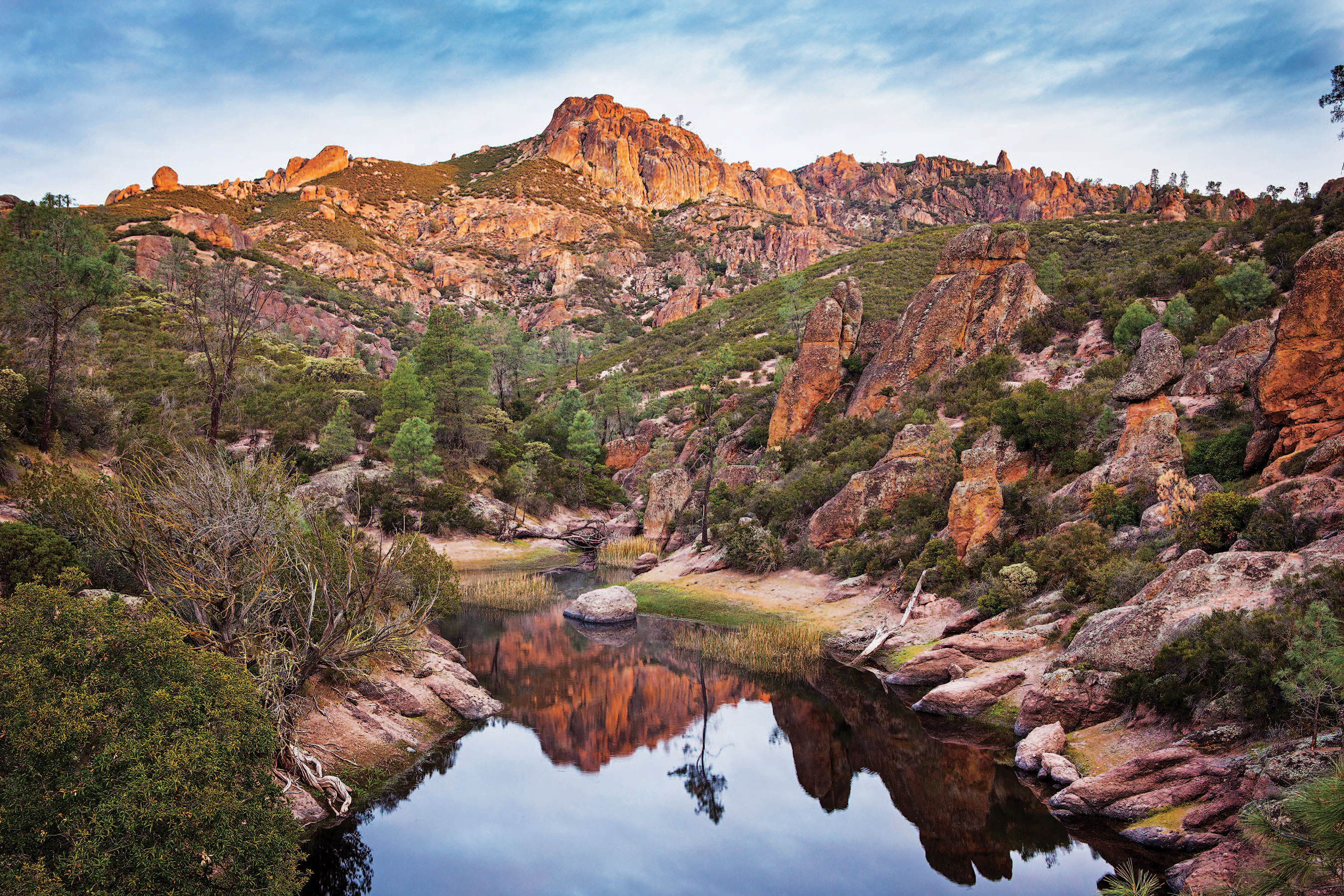
Pinnacle of the Parks
Prior to its official inception in 1916, the National Park Service already had strong roots in the West with the original 10 parks dotting the map across Wyoming, Montana, Washington, Oregon, Colorado, South Dakota, and California, which alone now have nine parks. And even today, more than a century after President Woodrow Wilson signed the Organic Act, the West is still home to the majority of the 59 parks and even more national monuments.
The youngest of the parks, established back in 2013 (it had been a designated national monument since 1908), continues the legacy that the founding fathers of the national parks envisioned for conserving and protecting America’s most sacred natural treasures. Pinnacles National Park in the coastal hills of California has deep gorges and caves fit for any adventure. The ancient volcanic rock creates a jagged landscape and hiking paths through forests and canyons. Between rock climbing, bird-watching, camping, and hiking, Pinnacles captivates visitors with its breathtaking landscapes and extensive opportunities to experience nature.
—Victoria Mechler
Learn more about the National Park Service on the official website. Read more about our favorite national parks and the NPS.
Opry on the Airwaves and Online
At nearly a century old, the Nashville AM radio station WSM 650 remains a relevant influencer in the country music world. That’s because it lifts up the genre’s rich and important traditions with every broadcast. A couple of months after its 1925 debut in Music City, the station began airing Grand Ole Opry broadcasts, in effect becoming a loudspeaker for country legends in the making. Tune in to WSM in Nashville or just about anywhere in the world (via online stream or app) and you’ll still hear live Opry broadcasts on Tuesday, Friday, and Saturday nights. There are also bluegrass and Americana shows, as well as programming blocks hosted by artist Tracy Lawrence and renowned DJs Eddie Stubbs and Bill Cody. Simply put, if the newfangled pop-country on your local station doesn’t please you, WSM’s more traditional and twangy sounds are but a click away. Its site has a deep archive of Opry broadcasts and other programs, as well.
— Hunter Hauk
Listen to WSM or get its app online now.
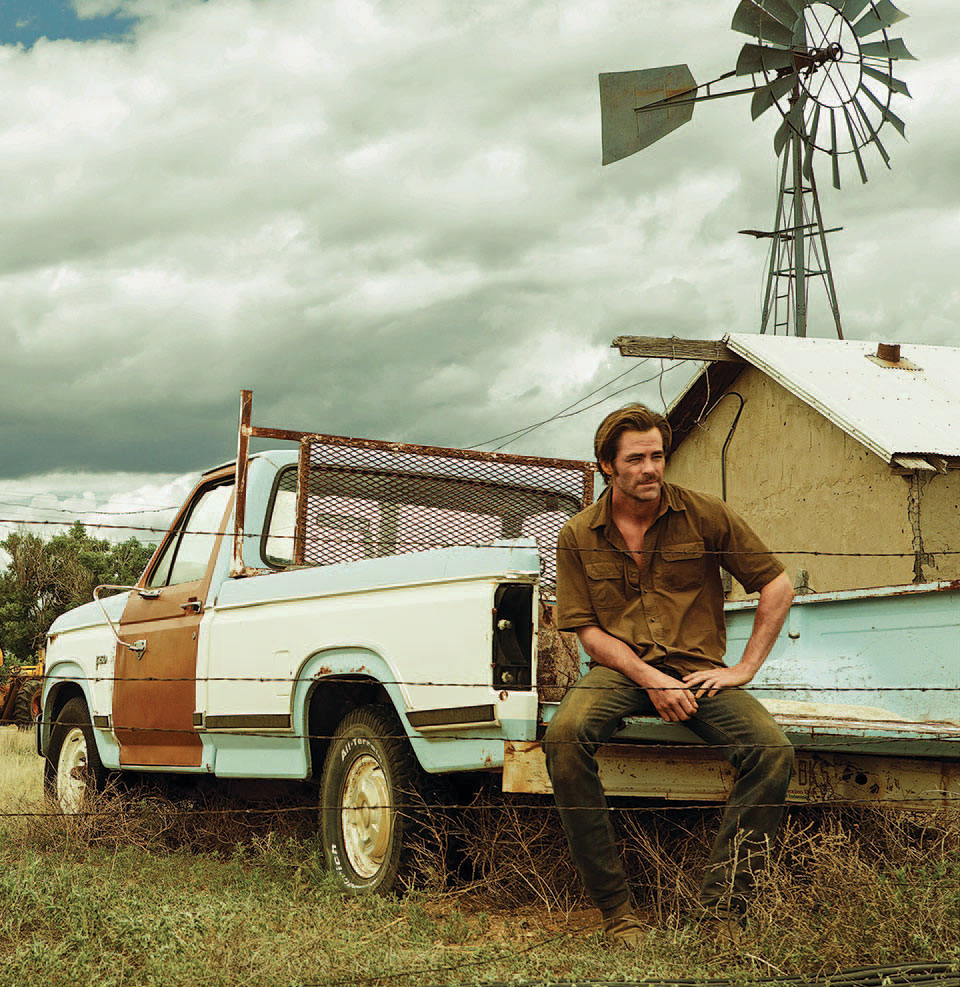
Influence of the Western
An obsessed man hunts for a girl who has been snatched by savages. Two desperate brothers rob banks to save their homestead, while dedicated Texas Rangers doggedly pursue them. An outlaw attempts to run away from his past — and his reputation — but realizes that a man’s got to do what a man’s got to do.
Do those sound like plots for classic westerns? Of course. But they’re also the story lines for three recent contemporary dramas that belong — along with TV series like Justified and Longmire, and movies as diverse as Lone Star and No Country for Old Men — to a genre best described as the modern-day western. Such films serve to remind us: The West is a state of mind and a way of life, not just a point on the compass.
In Les Cowboys, the directorial debut of award-winning screenwriter Thomas Bidegain, a French father steeped in western lore spends years searching for his daughter, who may have allied herself with Islamic terrorists. In plotting the film, Bidegain told C&I last year, “The idea we had is that it starts like The Searchers but it ends up like Cheyenne Autumn. It’s like [the protagonist] starts with the early John Ford way of seeing the world. He ends up in the more mixed and more complicated way.”
Jeff Bridges and Gil Birmingham play the Texas Rangers on the trail of criminal siblings (Chris Pine, Ben Foster) in Hell or High Water, David Mackenzie’s critically acclaimed film that laces its gripping fiction with the harsh economic realities of modern-day West Texas. Mackenzie aptly described his Oscar-nominated drama to Deadline.com as “a snapshot of contemporary America with resonance of the past, a slightly poetic song to the change of the Old West.”
And while Logan is first and foremost a comic book fantasy about an aging superhero — specifically, the X-Men’s Wolverine, played by Hugh Jackman — director James Mangold (3:10 to Yuma) has admitted a debt to Shane in fashioning his tale about a dangerous outcast linked to an admiring youngster. The scene in which Mangold openly acknowledges that debt arguably is the best moment in the entire movie.
— Joe Leydon
The Chief Joseph Trail Ride
In 1877, a large band of the Nez Perce tribe fled from the U.S. Cavalry and headed to Canada in an attempt to avoid being forced onto a reservation. After more than 1,170 miles of trekking through what are now Oregon, Idaho, Wyoming, and Montana, their grueling journey came to a devastating end when nearly 800 warriors, women, children, and elders were forced to surrender just 40 miles from the border, following a final bloody battle north of the Bears Paw Mountains and a journey that had left many of the band starved and broken from severe exhaustion.
In 1986, the trail became part of the National Trail System Act. But well before that, beginning in 1965, the Idaho-based Appaloosa Horse Club began inviting riders with access to an Appaloosa (the spotted breed of the Nez Perce) the opportunity to travel the same route. The Chief Joseph Trail Ride — named for the famed Nez Perce leader who resisted the band’s removal from their ancestral lands and guided them in a bid for freedom in Canada — covers roughly 100 miles each year, beginning where the trail ended the previous year and taking 13 years to complete the entire route.
With marvelous views and significant historical stops, the ride has been called “part pilgrimage, part adventure, and part social gathering.” The 2016 ride, which ended at Bear Paw Battlefield in Montana, marked the last leg of the trail. This year’s ride — July 17 – 21 — marks the fifth time the trail has begun where the tribe did. Assembled at what are now the Chief Joseph Rodeo grounds in Joseph, Oregon, riders might hear the great Nez Perce leader quoted: “The earth is the mother of all people, and all people should have equal rights upon it.”
— Kristin Brown
For ride application and more information, visit the organization online.
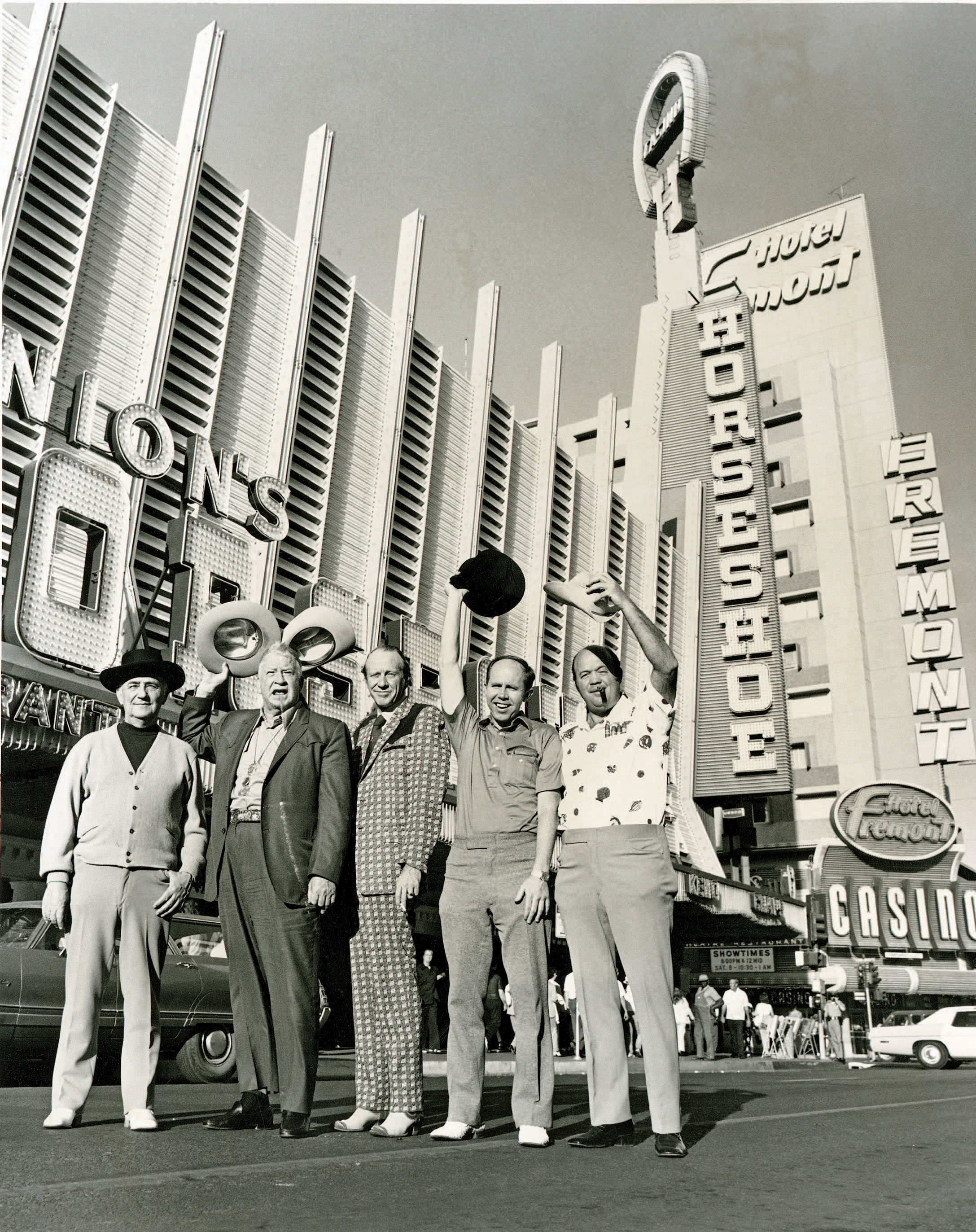
Texas Hold ’em
One can scarcely imagine the Old West without picturing cowboys, outlaws, cardsharps, and painted ladies engaged in a game of poker, friendly or otherwise. Poker has a significant place in the culture of the modern West, too, and today the game Texas hold ’em is all but synonymous with poker.
Hold ’em is generally thought to have originated in the early 1900s in Robstown, Texas, and the Texas Legislature officially recognizes the town as its birthplace. Road gamblers like Doyle Brunson, Thomas Austin Preston Jr. — better known as Amarillo Slim — and Crandell Addington were enamored of the “thinking man’s game.” In this poker variation, each player is dealt two hole cards. After an initial round of betting, three communal cards are laid face-up, followed by a fourth and a fifth, with another round of betting after each deal.
Addington says it was a staple of a game room at Tom Moore’s house in Castle Hills, an enclave of San Antonio, in 1963. At this underground home casino, he says, one of the crucial rules was: Don’t beat the sheriff, who appeared once a month.
“The two bosses would bluff off money to him, and after a while he’d get up and cash out,” Addington says. “This was the biggest game in the United States. It was easy to win 10, 15, 20 thousand a night.”
In 1967, Moore asked Addington to join him in Reno, Nevada, where Moore acquired the Holiday Hotel and Casino. They and other Texas gamers took hold ’em to Reno and Las Vegas, whereupon “Texas” was added to the moniker. The game was a hit at the Dunes Hotel in Las Vegas, where drop-ins would be lured by the action even when they had no idea how to play. “We’d say, ‘Here’s a short lesson,’ ” Addington says, laughing. Expensive as the tutorials could be, the game grew ever more popular.
What Addington likes about the game is that “it’s almost 2½ to 1 that you can take any unpaired hand and the flop will not pair either card. ... Doyle and I were talking about it and said, ‘This is a game where you can make more money playing your opponent’s hand than your own.’ ”
They also liked that even the best stud players had a steep learning curve with the game, which was lucrative for the Texans who’d been playing for years.
In 1969, Moore held a poker event and invited hustlers and gamblers including Addington, Brunson, Amarillo Slim, Benny Binion, Minnesota Fats, and Charles Harrelson — father of Woody and a notorious hit man later convicted of the 1979 murder of a federal judge in San Antonio.
“Everybody knew he was a killer, but he couldn’t play, either,” Addington — who came out on top at the event — says.
Famed casino owner and, let’s say, “colorful character” Lester “Benny” Binion acquired the concept of this poker invitational from Moore, and the next year held it at his Horseshoe casino in Vegas.
“It wasn’t a tournament — everybody played for cash — and it was all different games,” Addington says. “That year, [Benny’s son] Jack Binion lost count of it. So he came around and asked everyone, ‘Who do you think was the best player?’ And everyone said themselves. So he went around and asked, ‘So who do you think was the second-best player?’ and Johnny Moss was voted the winner.”
It evolved into a tournament-style event and was dubbed the World Series of Poker in 1971, and the next year, a $10,000 buy-in no-limit Texas hold ’em tournament was the main event, cementing the game’s place in gambling lore.
— Jesse Hughey
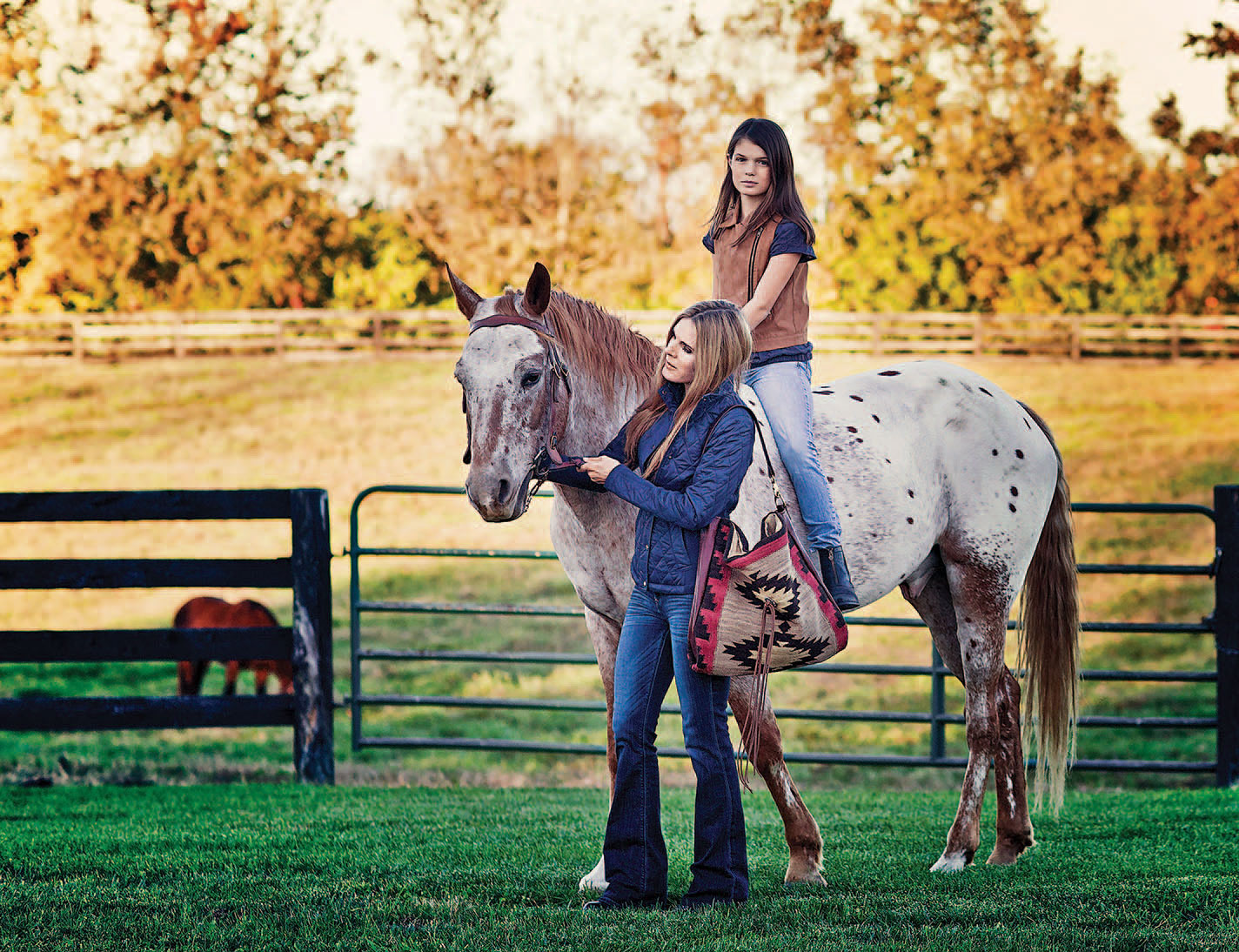
Living Out a Legacy
If you follow Western fashion, you’re most likely familiar with saddle blanket bags. In recent years, handbags crafted from vintage wool weavings have become increasingly popular for their colorful, bold designs and one-of-a-kind nature. But none are quite like those of Hope Unlimited Bags. What sets this collection apart — aside from a refined sense of style and artisan craftsmanship — is the woman behind it.
Hope Unlimited is the latest passion project of Jennie Turner Garlington — environmentalist, philanthropist, and daughter of renowned media mogul/rancher Ted Turner (she is also the producer of the PBS series EcoSense for Living). Garlington began designing totes in 2015 with her daughter, Hope, incorporating vintage pieces and collectors items found on their many travels together. Their bags were so well-received by family and friends that by the end of the year, they’d officially launched their own line of satchels, each one unique, meaningful, and oversized for toting all the necessities of your own adventures.
“These bags are real works of art and very personal,” Garlington says. “We take all kinds of time designing them, which makes each one all the more meaningful. ... After Hope and I find the perfect way to accessorize and design them, we work in lockstep with a local craftsman who actually hand-sews the bags on an antique Singer machine.”
—Holly Henderson
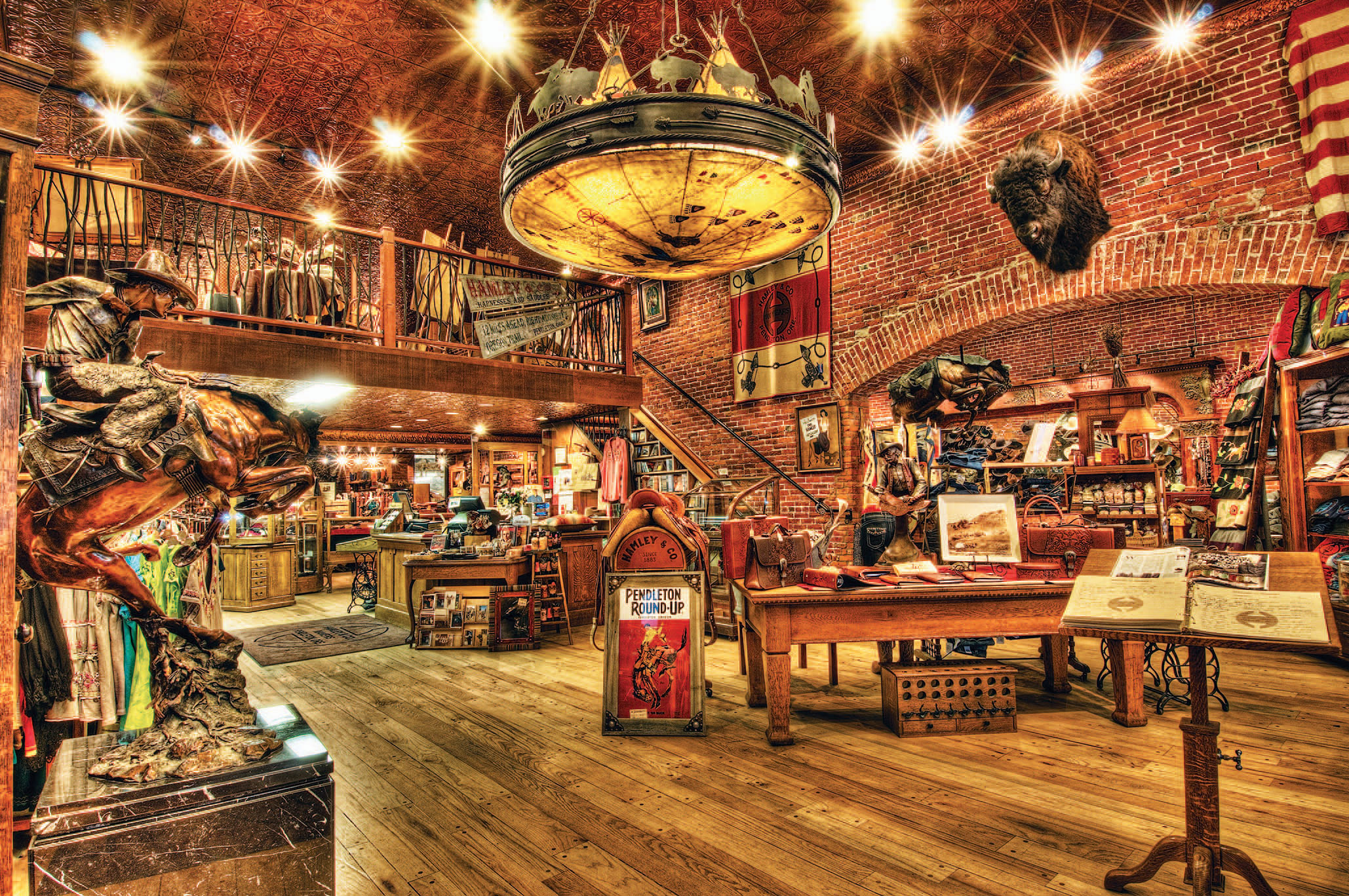
Hamley’s Western Store
Western culture relishes tradition, and it relishes handcrafted objects probably more than any other American culture,” says Parley Pearce, owner of Pendleton, Oregon-based Hamley’s Western Store, a renowned saddlemaker and cowboy outfitter. Although Hamley’s came to prominence as a one-of-a-kind Western shop in Pendleton, the business’ history stretches back to 1840 when saddlemaker and leather craftsman William Hamley emigrated from England to the Midwestern United States. But it wasn’t until 1905 that Hamley’s descendants set up shop in the building that it still occupies. The operation quickly earned prestige for its custom saddles and its dedication to the principles of the West. Later, it expanded inventory to include jewelry and apparel, all the while expanding the art of custom saddlemaking. “If you don’t start with a good saddle, your horse isn’t going to respond as well as it would if it were sized correctly,” Pearce says. “The cowboy isn’t going to be comfortable and able to do what he needs to do to get the job done. It’s significant.”
The Hamley’s brand remains synonymous with Western excellence. It could easily rest on its handcrafted laurels. But Pearce — who purchased the business with a check and a handshake — believes in keeping the Western spirit alive while pushing forward. Hamley Steakhouse, adjacent to the original store, opened in 2007. Award-winning saddlemaker Jean-Pierre “Pedro” Pedrini, whom Pearce calls “the best living saddlemaker in America,” recently came onboard and will be charged with creating a special 175th anniversary saddle. What’s more, Pearce is renovating Pendleton’s Oak Hotel, a structure behind Hamley’s, which in its past life was an Old West brothel. He expects to open it next year as downtown’s first boutique hotel, one that combines an Old West feel with modern comforts, proving yet again that progress doesn’t mean losing the values we hold dear.
— José R. Ralat
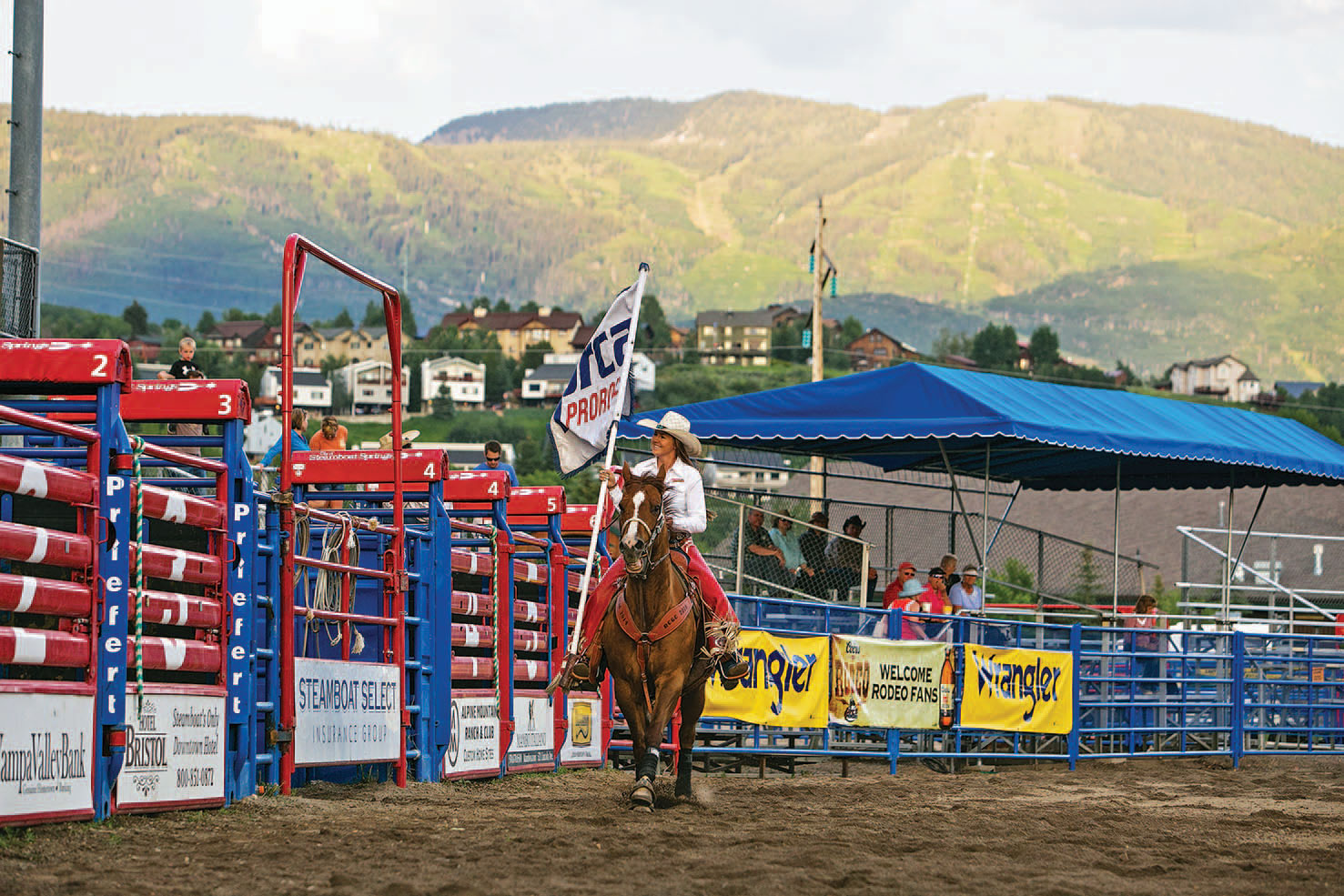
Rodeo in a Small Town
The thousands who make trips to the Wrangler National Finals Rodeo and The American are onto something. Big-ticket rodeo combines the risks of extreme sports, the spectacle of a concert, and a fan presence rivaling any NFL game. Yet, if you asked around in the stands, you might find that many of those fans developed their love for buckin’ and ropin’ in much smaller arenas. Tiny towns all over are where rodeo dreams begin, where road-warrior athletes put skills to the test and build confidence that a championship buckle requires. Up-close access is just one facet of the small-town-rodeo experience. In most of these communities, rodeo is at the center of a character-shaping culture. Think stock shows, country concerts, high-hair pageants, and the social scene at the concession stands. Rather than big-budget lighting and collapsible roofs, small-town-rodeo crowds see the sky and sometimes mountains in the distance. It’s on a smaller scale, but it leaves an equally strong impression. Find rodeos in every state at rodeosusa.com, or visit one of our favorites on the town circuit this summer.
— Hunter Hauk
Stonewall Peach JAMboree and Rodeo
June 16 and 17 in Stonewall, Texas
Flagstaff Pro Rodeo
June 22 – 24 in Flagstaff, Arizona
Steamboat Springs Pro Rodeo
Fridays and Saturdays beginning June 16 in Steamboat Springs, Colorado
St. Paul Rodeo
June 30 – July 4 in St. Paul, Oregon
Days of the Old West Rodeo
July 2 – 4 in Hailey, Idaho
From the May/June 2017 issue.



